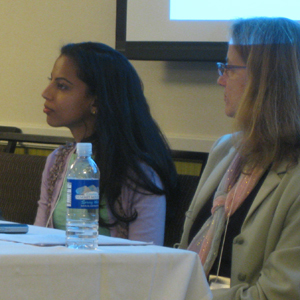 ATLANTA — “Any time a child has to go to juvenile court on a delinquent charge, or an unruly charge, that child is at a disadvantage,” said Linda Pace, a public defender from Dekalb County, Ga., at the 2013 Georgia Youth Law Conference. “Developmentally, experientially, they are simply not equipped to be in that forum without some help.”
ATLANTA — “Any time a child has to go to juvenile court on a delinquent charge, or an unruly charge, that child is at a disadvantage,” said Linda Pace, a public defender from Dekalb County, Ga., at the 2013 Georgia Youth Law Conference. “Developmentally, experientially, they are simply not equipped to be in that forum without some help.”
On Monday, Pace was one of four speakers that presented at a general session titled “Representing Parents, Youth and Children with Special Needs — Perspectives from Deprivation, Delinquency and Education Presenters.” Joining Pace were presenters Katherine Terry (a child advocate lawyer from Decatur, Ga.), Emma Hetherington (a staff attorney at the Georgia Law Center for the Homeless) and Aarti Sharma (an Equal Justice Works Fellow for Fulton County CASA.)
The nature of criminal law, Pace said, was “foreign” to the way most children think. “We know a lot about brain development, and they just have not really, for the most part, reached an age where any of this makes a lot of sense to them,” she said. “It’s the amount, and the type of help, that children who have disabilities need that differs and makes them a little more challenging than other clients.”
A juvenile defender’s primary function, she said, is to be the best attorney he or she can possibly be for that child. This is true, she said, even when parents — and sometimes, treatment providers — refer children to the juvenile court, under the assumption that the system is the best outlet for acquiring services.
Many children juvenile defense attorneys encounter, Pace stated, have had negative experiences with adults, and may be distrustful of child welfare lawyers. She said that attorneys should acknowledge that each juvenile client is different, and that their respective experiences have shaped both their strengths and weaknesses as young people.
Sharma stressed that special education can include a wide array of services. “It can be a child being in the same classroom all day with non-disabled peers and simply getting extra support, or it can mean things like being pulled out for just one hour a day, for speech services,” she said.
Just because a child has a DSM-IV diagnosis, she continued, does not mean that a young person automatically qualifies for special education programming. For children with emotional or behavioral disorders, she said unless those disorders directly interfere with a child’s ability to handle academic curriculums, the child may not meet Individuals with Disabilities Education Act (IDEA) standards for behavioral educational supports.
Students with disabilities, Sharma said, are given school-suspensions and subjected to disciplinary actions at a disproportionate rate compared to other students. The effects of these suspensions, she stated, can be “horrific.”
Students excluded from the classroom, she said, are five times likelier to drop out of high school and are six times likelier than other students to be retained in a prior grade. “These students are three times more likely to enter the juvenile delinquency system,” she concluded. “This has huge impacts for all of our youth.”
Terry said that, nationally, approximately half of children in foster care have at least one special need diagnosis other than a mental health disorder. “It’s important to be familiar with diagnosed special needs, to know what that looks like, but also to be aware of what to look for,” she stated. “Because oftentimes, children come into our courts who don’t have diagnoses.”
Like Sharma, Terry said that professionals should avoid assessing children with special needs under broad categories. Families, culture and living circumstances, in addition to a child’s own individual behavior and attitude, should all be taken into consideration when young people with special needs are being represented, she believes.
“It’s very important that you get started right away if you suspect that a child may have undiagnosed special needs,” she said.
Hetherington made the point that attorneys representing both children and parents, need to know what the specific disabilities of their clients are, especially if the disabilities may have been a factor in a child being removed from a home.
When representing parents with disabilities, Hetherington said that attorneys need to take note of their income streams — particularly, Supplemental Security Income (SSI) and Supplemental Security Disability Insurance(SSDI) benefits — and address whether child neglect incidents may have arisen directly from the parents’ physical or mental disability.
“We need to know, in between these hearings, what services are our clients being provided,” she said. “Do they have mental health services, are their reasonable accommodations, do they need education services?”
A General Equivalency Diploma (GED), she said is not enough to make parents with less severe disabilities “job-ready.” She believes they require interviewing and resume-building skills, and perhaps vocational training, to gain long-term employment. Hetherington also said that there are many housing options available to parents with disabilities — not just individuals receiving SSI and SSDI benefits, but also, veterans, who are able to take advantage of the Housing and Urban Development’s Veteran Affairs Supportive Housing (HUD-VASH) program.
“At our office, we like to think of ourselves not just as attorneys, but as social workers,” Hetherington added. “The best interests of your client is sometimes making them go through their case plan and providing them with resources.”





























